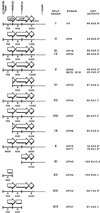Identification of a cytolethal distending toxin gene locus and features of a virulence-associated region in Actinobacillus actinomycetemcomitans
- PMID: 10024565
- PMCID: PMC96451
- DOI: 10.1128/IAI.67.3.1227-1237.1999
Identification of a cytolethal distending toxin gene locus and features of a virulence-associated region in Actinobacillus actinomycetemcomitans
Abstract
A genetic locus for a cytolethal distending toxin (CDT) was identified in a polymorphic region of the chromosome of Actinobacillus actinomycetemcomitans, a predominant oral pathogen. The locus was comprised of three open reading frames (ORFs) that had significant amino acid sequence similarity and more than 90% sequence identity to the cdtABC genes of some pathogenic Escherichia coli strains and Haemophilus ducreyi, respectively. Sonic extracts from recombinant E. coli, containing the A. actinomycetemcomitans ORFs, caused the distension and killing of Chinese hamster ovary cells characteristic of a CDT. Monoclonal antibodies made reactive with the CdtA, CdtB, and CdtC proteins of H. ducreyi recognized the corresponding gene products from the recombinant strain. CDT-like activities were no longer expressed by the recombinant strain when an OmegaKan-2 interposon was inserted into the cdtA and cdtB genes. Expression of the CDT-like activities in A. actinomycetemcomitans was strain specific. Naturally occurring expression-negative strains had large deletions within the region of the cdt locus. The cdtABC genes were flanked by an ORF (virulence plasmid protein), a partial ORF (integrase), and DNA sequences (bacteriophage integration site) characteristic of virulence-associated regions. These results provide evidence for a functional CDT in a human oral pathogen.
Figures






References
-
- Altschul S F, Gish W, Miller W, Myers E W, Lipman D J. Basic local alignment search tool. J Mol Biol. 1990;215:403–410. - PubMed
-
- Anderson J D, MacNab A J, Gransden W R, Damm S A M, Johnson W M, Lior H. Gastroenteritis and encephalopathy associated with a strain of Escherichia coli O55:K59:H4 that produced a cytolethal distending toxin. Pediatr Infect Dis J. 1987;6:1135–1136. - PubMed
Publication types
MeSH terms
Substances
Associated data
- Actions
Grants and funding
LinkOut - more resources
Full Text Sources
Other Literature Sources
Molecular Biology Databases

